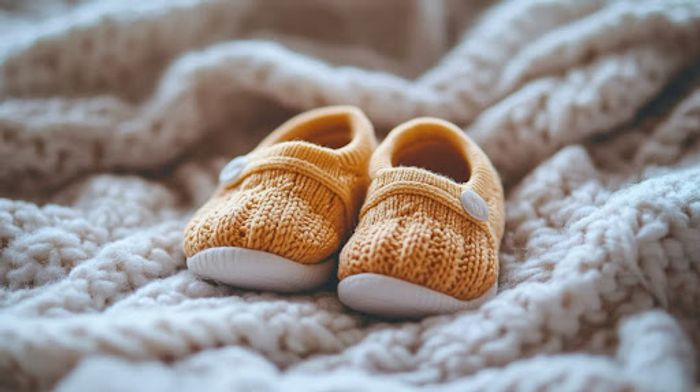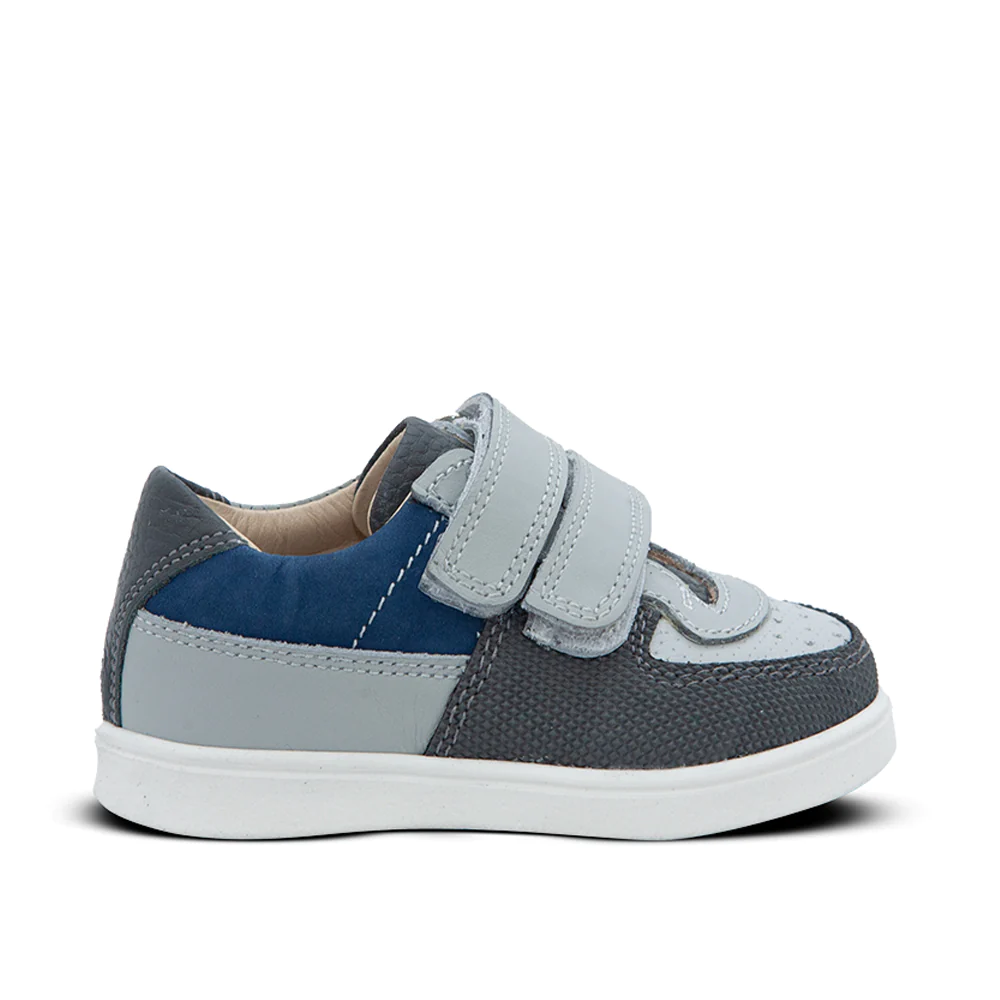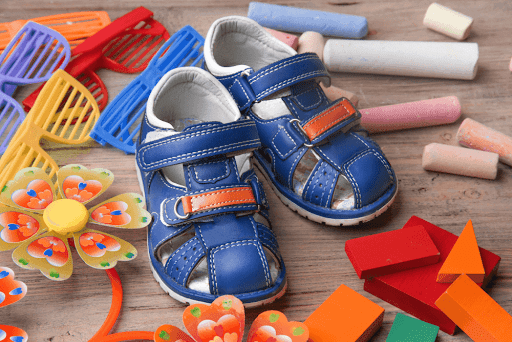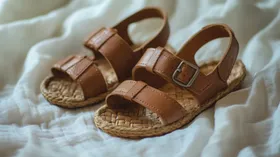What Are the Best First Shoes for Your Baby? A Complete Guide for Parents
From soft soles to supportive structures, this comprehensive guide empowers parents to choose the ideal first shoes, ensuring comfort and stability for their little one's walking journey
Published March 23, 2025.

Those tiny feet that once kicked inside your belly are now ready to take their first steps into the world. It's an exciting milestone when your baby begins to stand and cruise, but it also brings new considerations—especially when it comes to footwear.
Should they wear shoes? When should you introduce them? What features matter most? As a parent navigating this new territory, you deserve clear guidance to make informed choices for your little one's developing feet.
» Explore our collection of supportive and comfortable first shoes for kids
How Do Baby Feet Develop?
At birth, your little one's feet are predominantly cartilage—soft, flexible, and far from the sturdy structures they'll eventually become. During the first year, this cartilage gradually ossifies into bone as your baby prepares for weight-bearing activities.
Your baby's feet may appear flat—this is completely normal! The characteristic arch isn't visible yet due to a protective fat pad on the sole and because the ligaments that will eventually support the arch are still developing. These natural features are perfect for the pre-walking phase, and need no intervention or support.
Around 12 months, most babies reach the cruising milestone—holding onto furniture while taking sideways steps. This strengthens the muscles and ligaments needed for independent walking. During this transitional phase, your baby's feet continue to develop in preparation for those magical first steps.
» Learn to pick shoes for different stages of foot development
Barefoot vs. Shoes: What's Best for Development?
One of the most common questions new parents ask is: "When should my baby start wearing shoes?" The answer might surprise you—shoes aren't always necessary or even beneficial for newborns and pre-walkers.
During the non-walking stages, soft socks or booties are enough to keep their feet warm. Even as they begin to stand and take their first steps, being barefoot offers developmental advantages:
- Barefoot walking enhances sensory feedback through the feet, helping babies develop better balance, coordination, and proprioception (awareness of body position in space) that are essential for confident walking.
- Walking without shoes allows babies to feel different textures underfoot, which helps desensitize their feet and further improves coordination and sensory processing.
- The natural movement of barefoot walking strengthens intrinsic foot muscles and promotes healthy arch development and foot-ankle alignment.
For these reasons, paediatric podiatrists and developmental specialists often recommend babies go barefoot when it's safe and warm enough to do so, especially indoors during those crucial early stages of walking.
» Trying to find a perfect shoe for your kid? Dive into sizing for children's shoes
When to Introduce Shoes
While barefoot walking is ideal for development, there comes a time when shoes become necessary. Here's when to consider introducing your baby's first pair:
- When your baby begins walking outdoors, shoes provide essential protection from rough surfaces, sharp objects, extreme temperatures, and other potential hazards.
- In public spaces where barefoot walking isn't practical or hygienic.
- In cold weather when socks alone aren't sufficient to keep little feet warm.
The key is to remember that shoes for babies serve primarily as protection, not support. Their developing feet already have all the natural support they need, and overly structured shoes can actually interfere with healthy development.
» Find out how to measure your child's feet for shoes
The Risks of the Wrong Shoes
While we all want to see our babies in adorable tiny shoes, introducing footwear too early—or selecting styles that prioritise fashion over function—can interfere with healthy foot development in several ways:
Short-Term Impacts
Shoes that are too rigid or constrictive can create immediate challenges for your baby:
- Hindered Natural Movement: Rigid or constrictive shoes severely limit natural foot movement, preventing essential toe splay and flexion. This restriction directly impedes muscle activation crucial for healthy development, negatively affecting balance, gait, and coordination.
- Reduced Sensory Input: Thick, inflexible soles diminish crucial sensory feedback from the ground. This reduction in proprioceptive input can delay the development of balance and standing or walking abilities, increasing the risk of falls.
- Increased Muscular Strain: Heavy footwear places undue stress on developing muscles, making movement more challenging. This added burden can discourage practice of emerging motor skills, potentially delaying developmental milestones.
» Understand the best ways to treat toddler growing pains
Long-Term Concerns
The effects of inappropriate early footwear can extend well beyond the toddler years:
- Reduced Arch Development: The arch of your baby's foot develops naturally through the strengthening of intrinsic foot muscles. Shoes with premature arch support or overly restrictive designs can interfere with this process, potentially leading to flat feet or overpronation later in life.
- Altered Gait: Rigid shoes may encourage compensatory movement patterns as your baby tries to overcome the restrictions. These altered gait mechanics can become habitual, potentially leading to issues such as toe-walking or improper weight distribution.
» Learn more about the effects of improperly sized shoes on children
Must-Have Features for Your Baby's First Shoes
Shopping for your little one's first pair of shoes? Here's what to look for to keep those tiny feet happy and developing properly:
Flexible, Thin Sole
Your baby's first shoes need to bend easily—think of them as a second skin rather than rigid foot containers! A flexible, thin sole lets your baby's foot move naturally, just like they would barefoot. This freedom helps all those tiny foot muscles develop properly while they figure out balance and walking patterns.
Plus, thinner soles let your baby actually feel the ground beneath them, which is super important for developing their sense of balance and learning where their body is in space—crucial skills for confident walking.
» Boost your little one's ankle strength with these high top shoes
Wide Toe Box
Ever noticed how your baby's feet look kind of square and chubby? That wide shape with splayed toes is totally normal and perfect for keeping them stable as they learn to stand and toddle around.
Look for shoes with plenty of room in the toe area to respect this natural width. This space allows their toes to spread and grip naturally during those wobbly first steps.
Shoes that pinch or squeeze their toes can mess with proper development and even lead to toe problems down the road. Roomier is definitely better!
Lightweight, Breathable Materials
Nobody wants to walk around in heavy boots, especially not a baby just figuring out how to lift their feet! Opt for super lightweight materials that won't weigh them down.
Just as important—shoes need to breathe! Materials that allow good airflow keep those adorable tiny feet cool and dry, preventing the sweaty situation that leads to blisters and irritation.
» Concerned about your child's foot blisters? Find out if popping them is the right choice
Adjustable Closures
Velcro straps or laces aren't just convenient for quick changes—they're essential for getting that just-right fit. These adjustable features let you make the shoes snug enough to stay on without slipping around (which can cause trips and falls) but not so tight they squeeze or pinch.
The bonus? As your baby's feet grow (and boy, do they grow fast!), you can loosen the closures to extend the life of the shoes a bit longer. It's a win for proper fit and your wallet.
Non-Slip Outsole
Those first steps are wobbly enough without adding slippery soles to the mix! A grippy, non-slip outsole gives your baby much-needed traction on all sorts of surfaces, from smooth kitchen floors to playground paths. This extra stability reduces tumbles while they're still getting the hang of this walking thing.
Choosing Shoes for Different Surfaces
The walking surface your baby encounters influences what type of sole features provide the best support and safety:
Hardwood Floors
Hardwood and other smooth indoor flooring can be particularly challenging for new walkers:
- Soft rubber soles with slight texture provide essential grip on potentially slippery surfaces without catching or creating trip hazards.
- Flexible soles are especially important on hard surfaces to allow natural foot movement and shock absorption.
» Check out why orthopaedic shoes are a game-changer for kids
Carpets
While carpeted floors offer natural cushioning, they present their own challenges:
- Lightweight, flexible soles allow babies to feel the surface beneath them even through carpeting, which helps with balance development.
- Overly thick or rigid soles should be avoided as they further reduce the already diminished sensory feedback that carpeting creates.
Grass and Outdoor Surfaces
Natural outdoor environments offer excellent developmental benefits but require appropriate protection:
- Shoes with good tread patterns provide stability on uneven or slippery natural surfaces.
- Water-resistant materials are helpful for wet grass or dewy mornings.
- Slightly more durable construction protects from rough textures while still allowing flexibility.
» Explore the top shock-absorbing shoes for kids who love to run and play
Frequent Travel
For families who travel often, consider versatile options that adapt to changing environments:
- For colder climates, enclosed shoes with good insulation keep tiny feet warm while maintaining flexibility. Natural materials like wool often provide warmth without overheating.
- In warmer environments, well-ventilated sandals with the same supportive features as closed shoes—secure closures, flexible soles, and proper width—allow for airflow while protecting developing feet.
» Learn how to find the perfect all-season shoes for your little one
First Shoes for Special Foot Considerations
Every baby is unique, and some may have specific foot characteristics that require special attention:
For babies with especially wide feet, shoes with adjustable closures and an extra-wide toe box prevent uncomfortable pressure and allow for natural movement. Some brands specifically cater to wider foot shapes.
If your baby has flat feet (remember that most babies appear flat-footed initially), focus on shoes that allow natural movement rather than adding too much arch support. The arch will develop through activity and movement, not from external support.
For babies with hypermobile joints, look for shoes with slightly more structure around the heel and ankle to provide gentle stability without restricting movement at the ball of the foot.
» Need more space? Learn how to stretch kids' shoes
Assessing Proper Fit
Finding the right size and ensuring a proper fit is crucial for your baby's comfort and development:
- Optimal Toe Space: A well-fitting shoe should provide approximately a half-inch of space between the longest toe and the shoe's front. This allows for natural foot movement and growth.
- Identifying Tightness: Regularly inspect your baby's feet after removing shoes. Red marks or indentations are clear indicators of a shoe that's too constricting.
- Recognizing Loose Fit: Frequent tripping or noticeable discomfort while walking may suggest the shoes are too large, hindering proper gait development.
- Regular Fit Checks: Due to the rapid growth of infants' feet, it's essential to assess shoe fit every 3–4 months to ensure continued comfort and support.
» Giving your kid new shoes? Here's how much wiggle room they need
Supporting Healthy Foot Growth
Baby feet develop best when they're free to move naturally, which means barefoot is actually ideal for most of their first year. All those sensations from different surfaces actually help your little one develop better balance and coordination as they figure out this whole walking thing.
When it's time for shoes—First Walkers has solutions for every environment. Their extra-wide options prevent uncomfortable pressure for babies with especially wide feet, while their designs focus on allowing natural movement rather than adding unnecessary arch support.
First Walkers also excels with their adjustable closures that allow for the perfect fit—snug enough to stay on without slipping but not so tight they squeeze or pinch. As baby's feet grow quickly, these adjustable features let parents extend the life of the shoes a bit longer.
Disclaimer: First Walkers' information is intended for educational and informational purposes related to toddler footwear and feet. We encourage you to consider individual circumstances and consult qualified orthopaedists about specific conditions.






